Author: Sid, IOSG Ventures
TL,DR;
The programmable layer on FIL, known as FVM, allows for the creation of trustless markets
This requires an off-chain market currently in existence, bringing FIL lending onto the chain, retail FIL holders pledging their FIL, and miners borrowing FIL from the pool
FIL lending essentially involves obtaining cash in advance by accumulating future rewards for miners, making FIL mining more capital efficient
In protocol design, there needs to be a clear trade-off between centralization, capital efficiency, and security
The size of the FIL borrowing market decreases over time, but factors such as stablecoin introduction can unlock opportunities to build unique projects on these protocols
Introduction
Launching a programmable layer on a battle-tested blockchain is often exciting. When the Bitcoin blockchain introduced Stacks (STX), a new paradigm of thinking emerged within the community built around it.
A similar scenario occurred when Filecoin introduced FVM. The powerful Filecoin community can now see its vision from a completely different perspective. Many of the ecosystem's challenges are now being addressed. Creating trustless markets through programmability is a key part of this.
Liquidity pledging on Filecoin is the first "Request-for-build" released by the Protocol Labs team and has been highly regarded. To understand this, let's first understand how Filecoin's economics work.
How Filecoin's incentives work
Unlike Ethereum's validators, Filecoin does not have a one-time pledge. Whenever miners provide storage space to clients, they need to use FIL as a pledge token. This pledge amount is used to seal storage blocks and keep the sealed storage blocks on the miner's device. This structure ensures that miners will store data for clients during the agreed-upon transaction period and will receive incentives in return. Incentives are distributed through PoSt (Proof of Space-time), where miners prove that they have stored the correct client data to receive rewards.
Miners are selected through a leader selection mechanism called DRAND. DRAND selects leaders based on some initial requirements and the percentage of network raw byte power controlled by miners.
Miners must continuously increase their raw byte power to be selected as leaders to mine blocks and receive rewards. This helps miners subsidize their storage costs.
While there are many factors constraining the supply of these incentives, for storage providers/miners to maximize their profits, they must strive to maximize RBP and attract more (and continue past) transactions.
This creates a positive feedback loop for the Filecoin network.
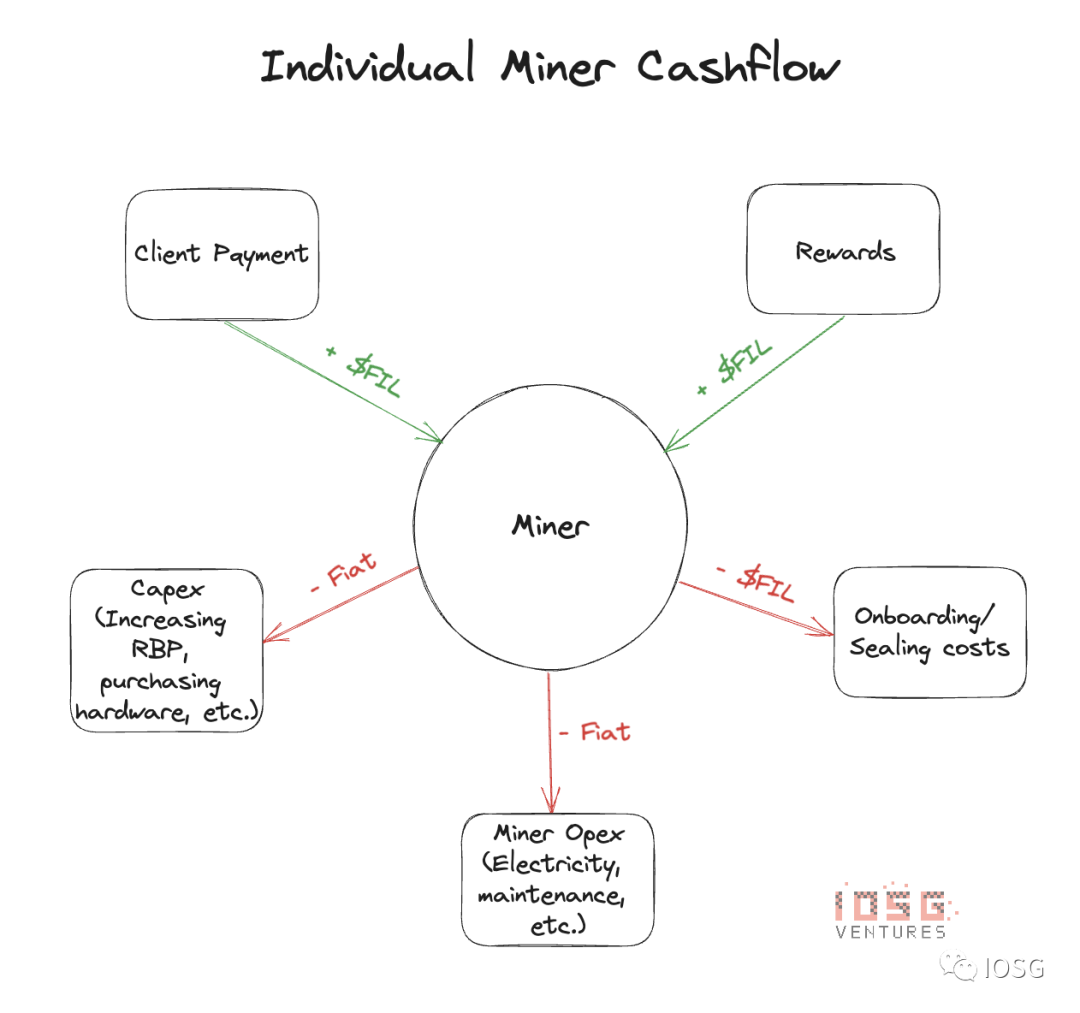
Miner Economics
When miners receive block rewards, these rewards are not liquid. Only 25% of the rewards are liquid, and the remaining 75% of block rewards are linearly unlocked within 180 days (approximately 6 months). This poses a problem for miners. Rewards that were supposed to be operational income for miners now become accounts payable that need to wait for payment until the miner attracts (or continues) transactions.
Let's take a look at the balances of top-ranked miners in the network (as of August 6, 2023).
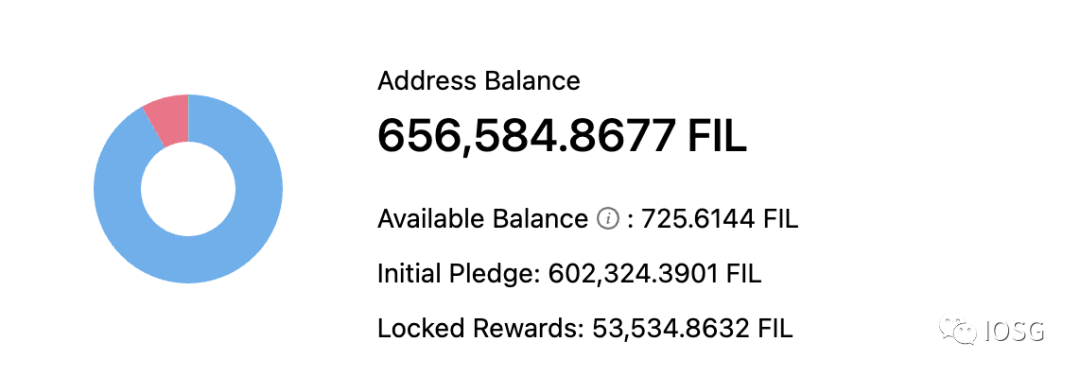
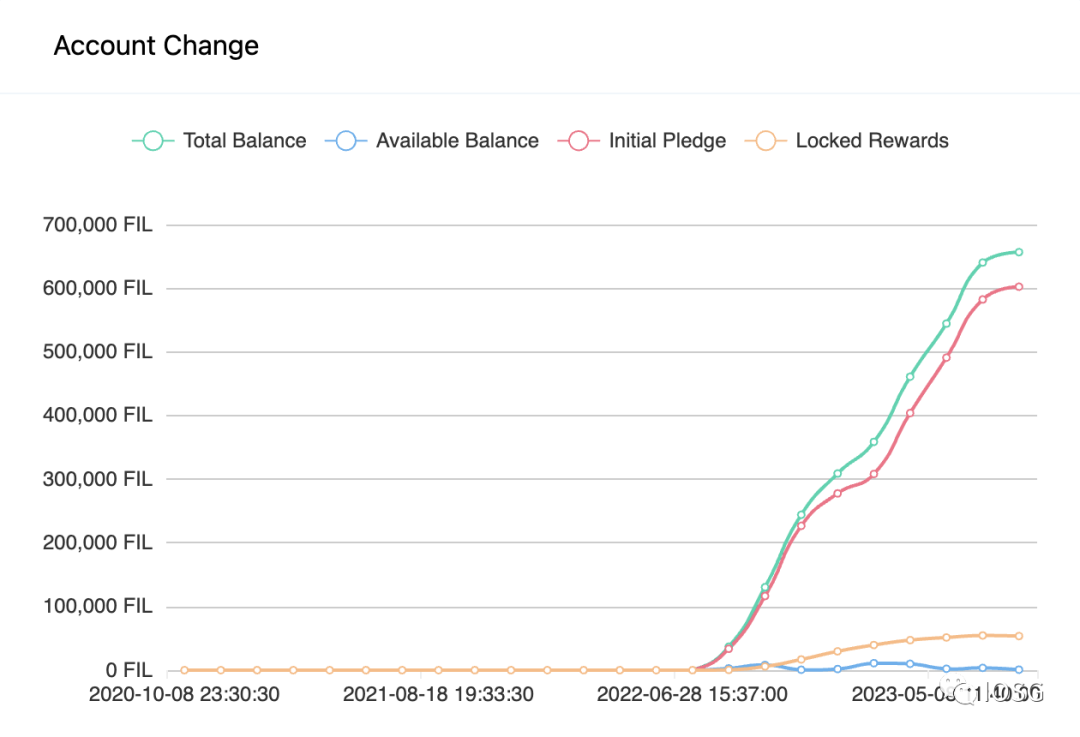 Source: FilFox
Source: FilFox
From the charts, it can be seen that miners actually have only about 1% of their rewards (or operational income) as liquid. If a miner wants to do any of the following:
Pay operational income
Upgrade hardware
Pay maintenance costs
Or attract/renew transactions
They will have to borrow fiat currency or borrow FIL tokens from a third party to make up for these "delayed" payments.
Currently, many storage providers (miners) in the network rely on CeFi borrowers such as DARMA Capital, Coinlist, and others. Since these are loan products, storage providers must go through KYC and strict audit processes to borrow FIL.
When we look at the map below, we can see that Filecoin miners are highly concentrated in the Asian region, while centralized service providers are mainly concentrated in the Western region. It is difficult for them to provide favorable FIL loans to Asian miners, and most Asian miners/storage providers cannot access these providers.
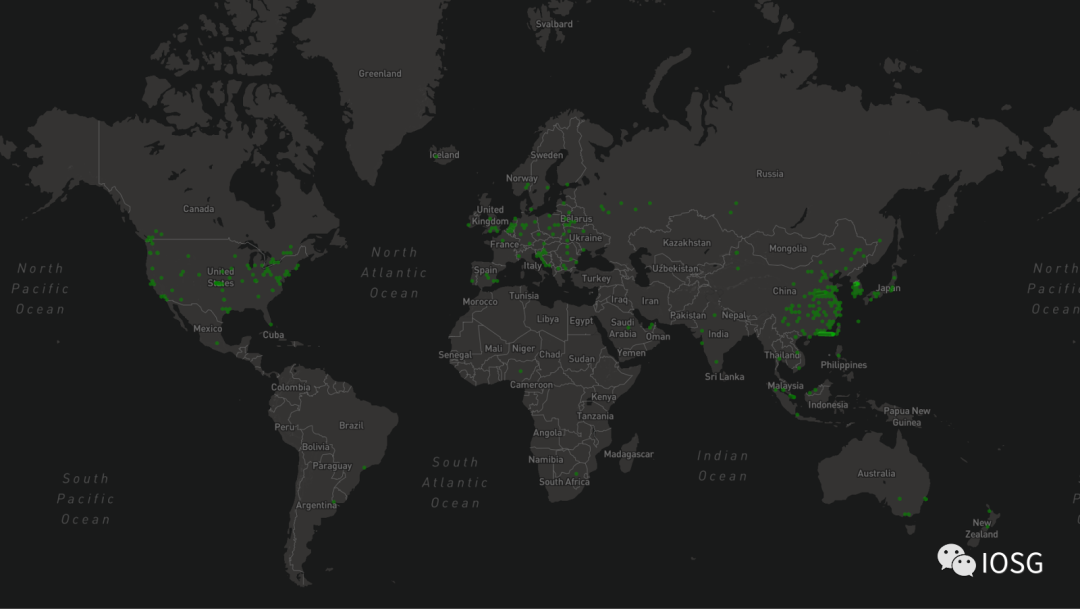 Source: Observable Dashboard by @jimpick
Source: Observable Dashboard by @jimpick
This not only hinders the entry of new miners but also limits the business scale of existing miners to the size of these CeFi loan pools.
So why not borrow fiat currency from a bank? Because FIL is volatile, this would bring additional capital management challenges for borrowing miners.
To solve this problem, a market needs to be established for FIL borrowers (miners) and lenders (FIL holders).
Filecoin Pledging
With the launch of FVM, this market concept has become a reality. FIL lenders/pledgers can now put their FIL tokens to work, and miners can borrow from this pool (in a licensed or permissionless manner), all managed by smart contracts.
Many participants in the ecosystem are already building this market and are preparing to launch it in the coming months.
Although such a market is referred to as a pledging protocol, from a business perspective, it is more akin to a lending protocol.
The basic features of such FIL lending products include:
Lenders pledge their surplus FIL tokens to obtain "liquid pledging" tokens.
Borrowers (miners) can borrow from the pool based on the collateral in the miner's smart roles (essentially the initial pledge amount + locked rewards).
Borrowers make interest payments every week or other specified time periods by transferring the miner's "OwnerID" to the smart contract.
Lenders receive interest (minus protocol fees) as an annualized yield (APY), which can be obtained by resetting tokens or accumulating token values.
Existing participants in the system include:
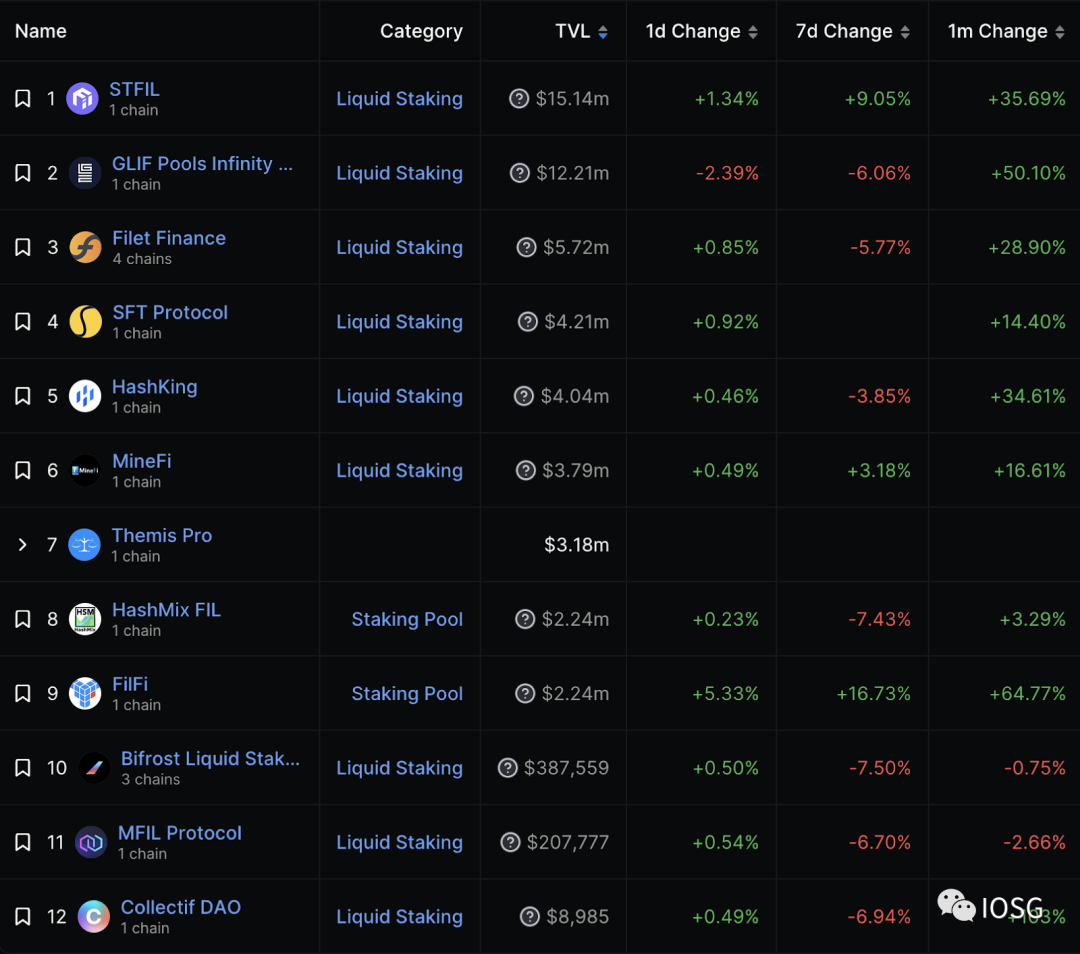 Source: DeFi Llama
Source: DeFi Llama
Different liquid pledging protocols have different approaches to borrowing:
Over-collateralization vs. Under-collateralization
In the over-collateralization or full-collateralization model, the debt-to-equity ratio is always less than or equal to 100%. This means that if my miner balance is 1000 FIL, I can borrow a maximum of 1000 FIL (depending on protocol rules). This can be easily encoded into smart contracts and has built-in default risk. It provides greater transparency and security for pledgers (lenders). Another advantage of this model is that it also allows for permissionless borrowing. In this case, the product is more like Aave/Compound rather than Lido or RocketPool.
In the under-collateralization model, the risk is borne by the borrower, and the risk is managed by the protocol. Risk modeling in this model is a complex mathematical calculation that cannot be embedded in smart contracts and needs to be done off-chain, sacrificing transparency. But because it involves leverage, the system is more capital efficient for borrowers. The more permissionless the leverage system, the greater the risk borne by the borrower, which will require a very robust dynamic risk management model run by protocol developers.
Trade-offs include:
Capital efficiency vs. pledger risk
Capital efficiency vs. transparency
Lender risk vs. borrower entry into the system
Single Pool vs. Multiple Pools
The protocol can also choose to build a multi-pool model, where lenders can choose to pledge FIL tokens in different pools with different risk parameters. This can achieve on-chain risk management, but liquidity will be dispersed. In a single pool model, risk will have to be managed off-chain. Overall, the trade-offs will be the same as those mentioned above.
Trade-offs include: Liquidity dispersion vs. risk management transparency
Risks
In the over-collateralization model, even if a miner is slashed multiple times, once the debt-to-equity ratio reaches 100%, the miner will be liquidated, and the pledger will be relatively safe.
In the under-collateralization model, if the borrower fails to prove storage blocks, they may be penalized. This is more common in Filecoin than in PoS-type models. This will affect the collateral value and increase the borrower's leverage. In this model, the liquidation threshold must be set very carefully.

Filecoin miner penalties (90 days). Source: Starboard
Comparison of Market Participants
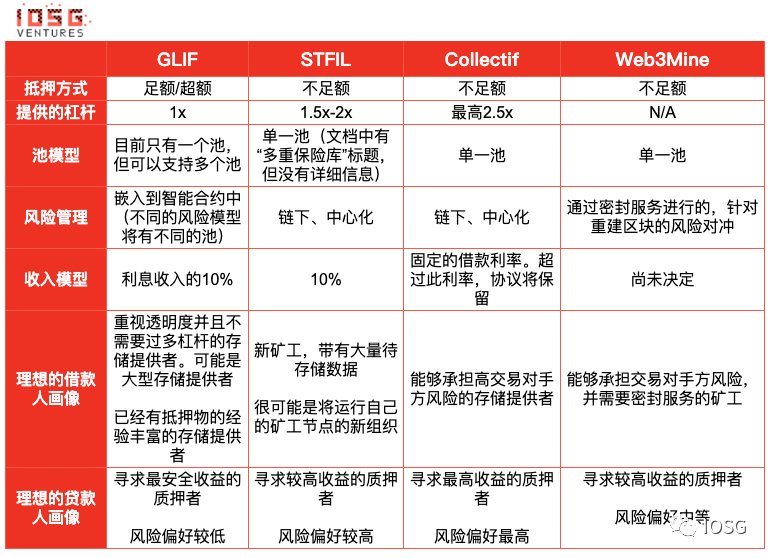
So what about the entry of Ethereum pledging/lending protocols into the market?
In the Filecoin ecosystem, unlike Ethereum, the responsibilities of nodes (miners/validators/storage providers) go far beyond just uptime. They need to self-market to be selected as storage providers (SPs), regularly upgrade hardware to support more storage, sealing, maintenance, and data retrieval. For SPs, Filecoin storage and mining rewards are a full-time job.
Unlike Ethereum validators, there is no one-time pledge in Filecoin. Whenever a storage provider offers storage to clients, they need to pledge a certain amount of tokens. This pledge is used to seal storage blocks and keep the sealed storage blocks on the miner's device. Providing storage on Filecoin is a very capital-intensive process, which makes many new miners unwilling to participate in the network and also discourages existing miners from staying and contributing to the network.
Since the participants on the borrowing side are limited to miners, establishing borrower trust in the Filecoin ecosystem will also be a resource-intensive process for newcomers.
Based solely on Filecoin's mechanism, Ethereum's staking and lending protocols cannot be easily deployed on FVM.
Protocol Economics
Is there enough FIL in the market to supply loans?
As of August 6, 2023, there are approximately 264.2 million FIL tokens in circulation, which are not committed as pledges for storage blocks or pending rewards, and can be considered the total number of FIL tokens pledged by lenders to the pool.
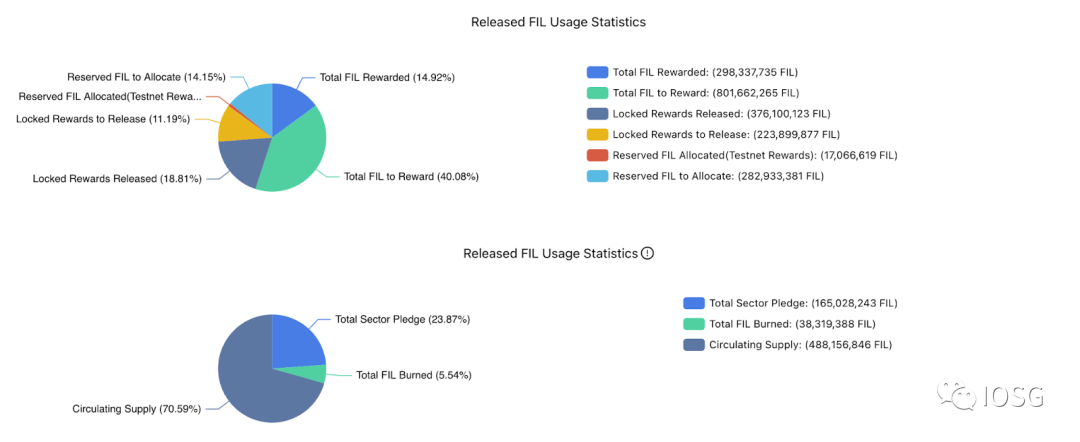
Source: FilScan
Is there enough loan demand?
While FIL lending is important for miners, what are they actually borrowing? In the over-collateralization model, they are making advance payments on locked rewards, while in the under-collateralization model, they are making advance payments on future rewards.
From the chart above, the total locked rewards are approximately 223 million FIL tokens, and the supply can meet the demand. The ratio of demand to supply is almost 84%. This shows the power dynamics on both sides, where neither side can exert pressure on the other in terms of interest/APY.
What will the future look like?
The estimate for the future FIL lending demand market is actually the number of FIL tokens released in future rewards.
Professionals at Messari simulated the circulation supply of FIL tokens for 3 and 50 years using different scenarios.
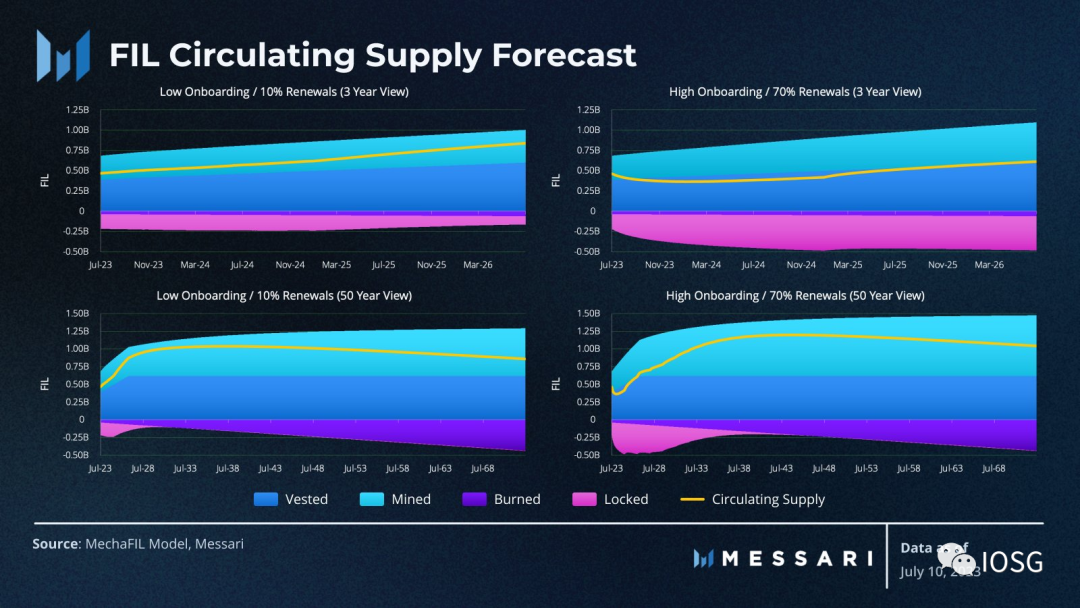
Source: Messari
According to the chart in the top left, in a conservative scenario, if the addition of data is low and only 10% of total transactions are renewed, the additional reward output in the future 3 years will be close to 100 million FIL tokens. In a more aggressive scenario, if the addition of data is high and 70% of existing transactions are renewed, the additional reward output will be approximately 200 million FIL tokens.
Therefore, it can be expected that the market size in the next 3 years will be between 100 million and 200 million FIL tokens. Based on the current FIL token price (August 6th at $4.16), the total available market size for lending (TAM) could be between $400 million and $800 million. This can be considered as the TAM for the borrowing side.
In terms of supply, in the conservative estimate, approximately 300 million FIL tokens will be generated, while in the more aggressive scenario, the circulating supply is simulated to be similar to today. Why is this? Because if more transactions are absorbed and renewed, more FIL tokens will be locked in pledges for storage blocks.
In the more aggressive scenario, demand will exceed supply, and in this competitive market, the interest charged may be higher.
If the demand for adding more data exceeds the growth of circulating supply, the price of FIL tokens will rise, creating more borrowing demand in FIL tokens.
Possible Future Directions for this Model
In different designs, there is no need to adopt a winner-takes-all model. Intuitively, in the long run (based on total locked value TVL), the protocol that is built the most securely usually wins, just like Lido in the Ethereum ecosystem. Rather than optimizing for a 2-3% yield, I prefer a more secure structure, and I believe FIL token holders would also prioritize capital security over slightly higher yields.
This is considering the penalties paid by miners for failing to prove storage time.
From the perspective of borrowers (miners), miners can borrow from different protocols to meet different purposes. If a miner already has a lot of collateral and does not need to pay operational costs through leverage, then the safer over-collateralization model will be more effective because it is safer. However, if I am a new miner and need to pledge a large amount of storage blocks, I may borrow from an under-collateralized pool.
By studying the above model, we can see:
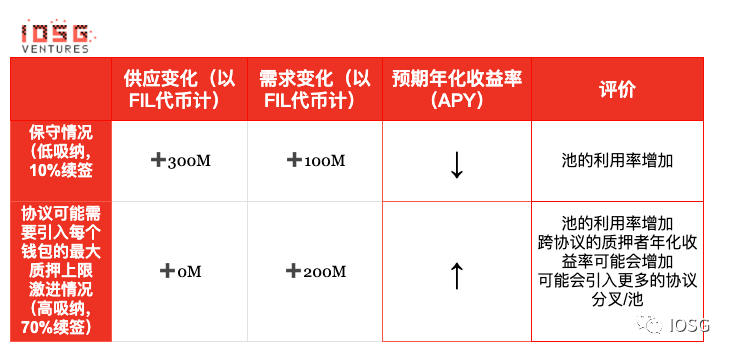
In Filecoin, pledging is crucial for bridging the supply-demand gap of FIL tokens in the ecosystem. FVM has recently been released, allowing the lending market to exist. While the issues are real, the release of FVM may have come too late for most FIL pledging/lending protocols, as the gradual decrease in mining rewards makes it a niche market.
However, there may be some intriguing use cases on top of these pledging protocols. With the introduction of stablecoins, rewards can be seen as cash advance contracts. Similar to the model built by Alkimiya on Ethereum. This can inject new capital into the Filecoin ecosystem and increase the total locked value (TVL) of these protocols.
The technologies of Ethereum and Filecoin are different, the miners are different, the developers are different, the applications are different, and therefore the communities are different. Especially for pledging, as each miner is "non-fungible," driving demand requires business expansion, and its success is directly proportional to the reputation of the protocol in the community.
Pledging in Filecoin is a key solution that needs to bring more miners into the system, put scattered funds into operation, create greater economic incentives, attract more developers to the ecosystem, and build useful products to establish a positive feedback loop. For more information beyond the importance of pledging in the Filecoin ecosystem and FVM, you can read our previously published article.
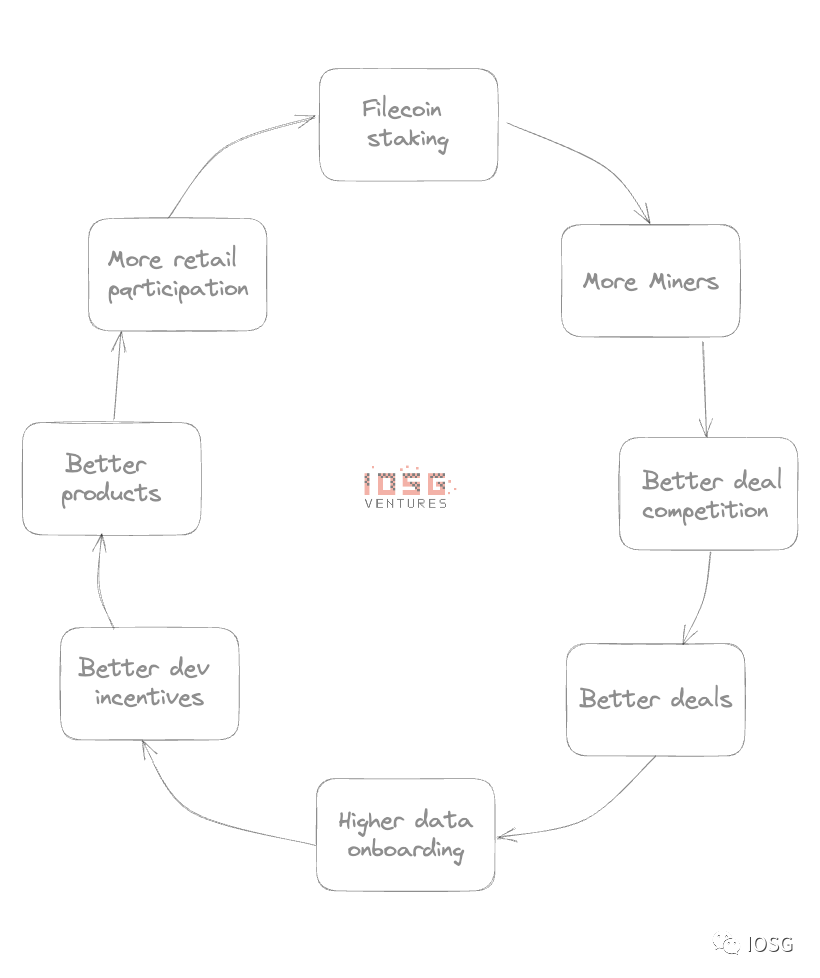
Conclusion
There are still many unresolved issues in the Filecoin ecosystem, but we believe that the Protocol Labs team is moving in the right direction to realize their vision of storing human data in an efficient system.
免责声明:本文章仅代表作者个人观点,不代表本平台的立场和观点。本文章仅供信息分享,不构成对任何人的任何投资建议。用户与作者之间的任何争议,与本平台无关。如网页中刊载的文章或图片涉及侵权,请提供相关的权利证明和身份证明发送邮件到support@aicoin.com,本平台相关工作人员将会进行核查。




